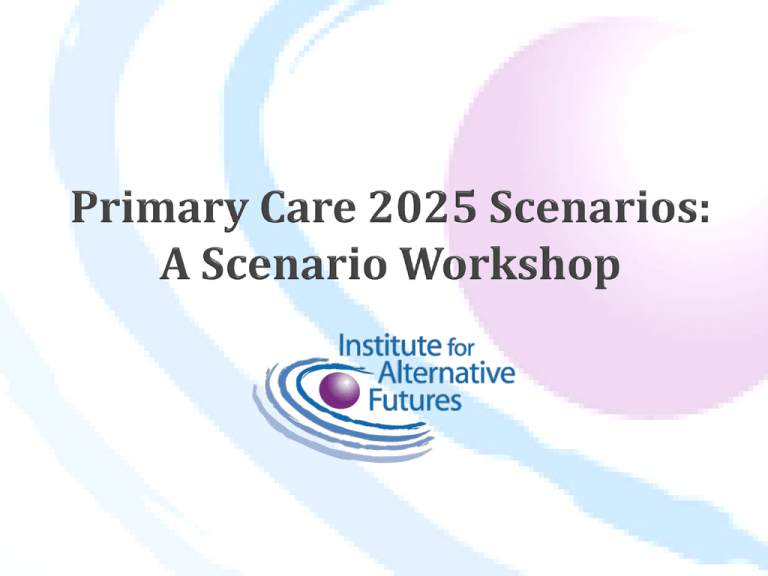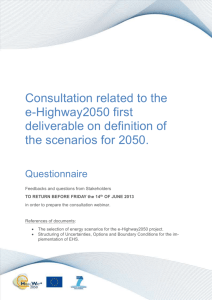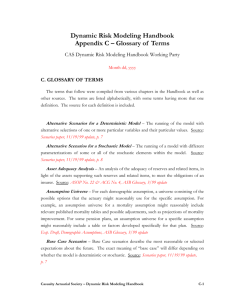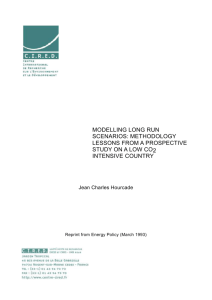Primary Care 2025 A Scenario Exploration
advertisement

The Kresge Foundation awarded IAF a grant to: * Develop scenarios for primary care * National Workshop of leaders using the scenarios * Use scenarios with Kresge and other organizations * www.altfutures.org/primarycare2025 2 * Scenarios are alternative stories about the future. * Scenarios bound uncertainty and explore major pathways. * Scenarios are used to understand change, clarify assumptions, track trends, consider alternatives, and develop vision. 3 * Consider what’s likely and what’s preferable. * Aid in understanding and creating the future. * Lead to enhanced focus on vision, visionary success, and sensitivity to opportunities. * Constructed around expectable, challenging, and visionary archetypes. 4 5 * Key forces and preliminary forecasts. * Interviews with 56 thought leaders and 10 focus groups. * With this input, IAF developed scenarios depicting: expectable, challenging, and visionary alternative futures of primary care. 6 7 An evolving definition: IOM (1978): Barbara Starfield (1992): Primary Care is Primary Care is * Accessible * First contact * Comprehensive * Accessibility * Coordinated * Longitudinality * Continuous * Comprehensiveness * Accountable IOM: Defining Primary Care: An Interim Report, 1994, page 27 8 The patient-centered medical home (PCMH) is a centerpiece in defining primary care. Its features include: * * * * * * * * * Enhanced access to care Care continuity Practice-based team care Comprehensive care Coordinated care Population management Patient self-management Health IT Evidence-based * * * * * Care plans Patient-centered care Shared decision-making Cultural competency Quality measurement and improvement * Patient feedback * New payment systems Source: Four Primary Care Physician Organizations cited in Robert Berenson, Kelly Devers, Rachel Burton, “Will the Patient Centered Medical Home Transform the Delivery of Care?” August 2011, The Urban Institute. 9 Still Emerging Models: • Comprehensive Health Home • Community Centered Health Home vs. • No Home, episodic, disjointed care vs. • Self care, My Home 10 Macroenvironment Recession or Recovery? Federal Debt & Deficits Internet, Social Media, Virtual Reality Transparency, Empowered Consumers Aging 11 Health care and primary care Unsustainable health care costs Health reform (implementing ACA, or not) Pressure for cuts in Medicare and Medicaid payments Defining health care quality as the “Triple Aim” Recognizing Population Health/Social Determinants Role 12 Labor Productivity Growth & Employment Growth in U.S. 1990-2010 Improving productivity requires delivery model redesign, different provider quantity & mix, and engaging in a much higher value set of activities. This is essential for controlling health care costs. Kocher & Sahni. Rethinking Health Care Labor. N Engl J Med 2011;365:1370-1372 13 Behavior M1993 M2002 50% 40% Socioeconomic conditions Environment 20% Physical Healthcare 20% 10% CHR 30% 50% Social Genes HPC 40% 10% 15% 5% 30% 10% 10% 15% 25% 20% Source: 1993 – M = McGinnis and Foege, JAMA, 1993, 270, 2207-2212; 2002 - McGinnis, Russo, Knickman, 2002, Health Affairs, 21,3,83; HPC – “Healthy, Productive Canada, Final Report of the Senate Subcommittee on Population Health. June 2009; CHR = County Health Rankiings, 2010 www.countyhealthrankings.org/ Disparities Health Role Genetic Endowment Socioeconomic factors Prevention & Health Promotion Physical Health Care Role Behavioral Risk Factors Physiological Risk Factors Environment Medical Care Health & Function Disease & Injury Burden Morbidity & Death Well-Being Thriving Resilient Resilience Determinants & Factors Individual Intermediate States of Quality of Outcomes Health life, Risk Able to do Factors your Job 15 Health care and primary care (cont.) The primary care team Payment – Integrated, Semi-integrated, Fee for Service Which home? PCMH evolving to Community Centered Health Home Self-care 16 * Payment approaches will shape primary care, who is on the team & what is done. * A base forecast for 2025: 40% Use integrated systems – capitated, continuity 30% Use semi-integrated systems – FFS & P4P 30% Use fee-for-service concierge for affluent; CHCs cover some of the poor, low income 17 = PCMH plus: * Work with community partners to collect data on social, economic, and community conditions * Aggregate health and safety data; systematically review health and safety trends * Identify priorities and strategies with community partners and coordinate activity * Act as community health advocates * Mobilize patient populations * Strengthen partnerships with local health care organizations and establish model organizational practices 18 1. Many Needs, Many Models 2. Lost Decade, Lost Health 3. Primary Care That Works for All 4. “I Am My Own Medical Home” 19 Mary is a 50-year-old, middle-income, single woman with diabetes. What would primary care be like for her in the four scenarios? 20 Expansion of PatientCentered Medical Home Home Some shortages of PCPs. All PCMH team members practice at top of license Prevention Where Americans receive primary care: 40% Use integrated systems – capitated, continuity 30% Use semi-integrated systems – FFS & P4P 30% Use fee-for-service – lucky poor use CHCs 21 Electronic Medical Records Personalized Vital Signs “Dr. Watson” Expert Support for providers Digital health agents, gaming, social networking 22 Employers drop insurance Health Insurance Exchanges Significant disparities remain for access and quality 23 Recurrent severe recessions Shortage of primary care providers Declining physician revenue Where Americans receive primary care: 30% Use fully integrated systems – capitated, continuity 20% Use semi-integrated systems – mixed FFS- P4P 35% Use fee-for-service – episodic, often poor quality 15% Use concierge fee-for-service – sophisticated tech. 24 Those with good insurance access great care with advanced technology Many more uninsured Many turn to black market care & unreliable online advice 25 Community * Expanded team of providers Centered Health Home Triple Aim Where Americans receive primary care: (Near universal health insurance coverage) 85% Use integrated systems – capitated, continuity 10% Use concierge fee-for-service 5% Uninsured use Community Health Centers & ERs 26 * Addressed local social & economic foundations for equitable health, creating healthy communities * Capitation – if it’s smart, we’ll pay for it (leading to reduced costs) 27 * Proactive electronic records, virtual access, coaching. * Advanced knowledge technologies and community mapping allow for identification and remediation of “hotspots” of ill health. Photo Credit: Arizona Department of Health Services (ADHS) Cancer by Community Health Analysis Area (CHAA). Accessed January 4, 2012. <http://www.azdhs.gov/phs/azchaa/>. 28 Advanced knowledge technologies allow self-care Wellness & disease mgmt. apps Personal health record Digital coach (“avatar”) Noninvasive biomonitoring Where Americans receive primary care: Facilitated Disease Network Big name vendors offer free avatar-based health coaching if other integrated health products and services are purchased 40% Consumer Directed Health Plans – self-managed care 40% Health Systems and Groups – primary care relationship in integrated systems 10% Concierge Practices – sophisticated personalized care 10% Uninsured – use ER and CHC when have to 29 * Much of the population opts for self-care and high deductible insurance. * Consumers buy health-related products and services through competitive markets that offer high transparency of costs and quality. * Demand for human primary care providers declines. * Health care costs are significantly reduced. 30 Scenario #1 Scenario #2 Scenario #3 Scenario #4 Many Needs, Lost Decade, Primary Care “I am my Many Models Lost Health that Works medical for All home” Characteristics of primary care Payment forms HIT, knowledge technologies Health Care share of GDP 31 Likelihood Preferability (0 to 100%) (0 to 100%) Scenario #1 Many Needs, Many Models Scenario #2 Lost Decade, Lost Health Scenario #3 Primary Care that Works for All Scenario #4 “I am my medical home” 32











